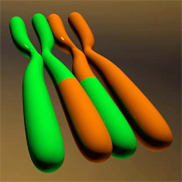
Recombination in meiosis.
Recombination occurs when two molecules of DNA exchange pieces of their genetic material with each other. One of the most notable examples of recombination takes place during meiosis (specifically, during prophase I), when homologous chromosomes line up in pairs and swap segments of DNA. This process, also known as crossing over, creates gametes that contain new combinations of genes, which helps maximize the genetic diversity of any offspring that result from the eventual union of two gametes during sexual reproduction.
Genetic diversity occurs because certain physical characteristics, like eye color, are variable; this variability is the result of alternate DNA sequences that code for the same physical characteristic. These sequences are commonly referred to as alleles. The various alleles associated with a specific trait are only slightly different from one another, and they are always found at the same location (or locus) within an organism's DNA. For example, no matter whether a person has blue eyes, brown eyes, or green eyes, the alleles for eye color are found in the same area of the same chromosome in all humans. The unique combination of alleles that all sexually reproducing organisms receive from their parents is the direct result of recombination during meiosis.
What happens during recombination?
Genetic recombination is a complex process that involves alignment of two homologous DNA strands, precise breakage of each strand, equal exchange of DNA segments between the two strands, and sealing of the resultant recombined DNA molecules through the action of enzymes called ligases. Despite the complexity of this process, recombination events occur with remarkable accuracy and precision in the vast majority of instances.
When recombination occurs during meiosis, the cell's homologous chromosomes line up extremely close to one another. Then, the DNA strand within each chromosome breaks in the exact same location, leaving two free ends. Each end then crosses over into the other chromosome and forms a connection called a chiasma. During this process, it is common for large sections of DNA containing many different genes to cross from one chromosome to another. Finally, as prophase I draws to a close and metaphase I begins, the crossing-over process concludes, and the homologous chromosomes prepare to separate. When the homologous chromosomes are later pulled apart during anaphase I, each chromosome carries new, unique allele combinations that are a direct result of recombination.
Does recombination occur in cells other than gametes?
Beyond its role in meiosis, recombination is important to somatic cells in eukaryotes because it can be used to help repair broken DNA, even when the break involves both strands of the double helix. These breaks are known as double-stranded breaks, or DSBs. When DSBs happen, a homologous chromosome can serve as the template for synthesis of whatever portion of the genetic material has been lost as a result of the break. Then, once synthesized, this new DNA can be incorporated into the broken DNA strand, thereby repairing it. In effect, this is a form of recombination, because the broken-off area is replaced with new material from a homologous chromosome. Recombination can also be used in a similar way to repair smaller, single-stranded breaks. In general, recombination can occur any time homologous chromosomes pair up, whether they are freely floating in tandem or lined up on the metaphase plate during meiosis.
More on recombination
Recombination isn't limited to eukaryotes, however. A special type of recombination called conjugation occurs in many prokaryotes, and it has been particularly well studied and characterized in E. coli bacteria. During conjugation, genetic material from one bacterium is transferred to another bacterium, and it is then recombined in the recipient cell. Recombination also plays important roles in DNA repair in prokaryotic organisms, just as it does in eukaryotic organisms.
















